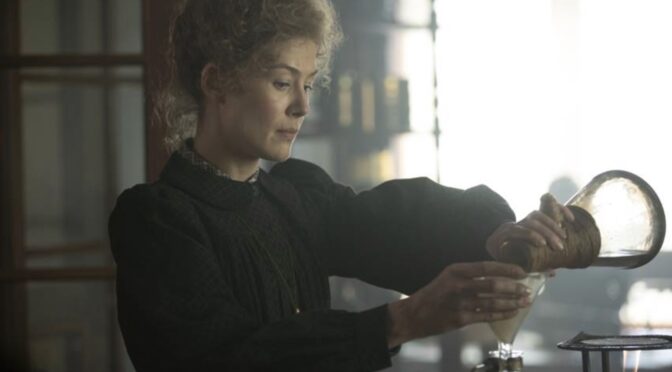 A biopic, at its best, can bring a historical figure to life in ways that leave audiences entertained, but also informed, about its subject. Be this through the use of an elegant framing device, as in I, TONYA, or the use of music to explore an artist, as in ROCKETMAN, the biopic is no longer simply a series of historical events on screen. For such a groundbreaking figure as Marie Curie, something special is needed, and adapting acclaimed graphic novel Radioactive: Marie & Pierre Curie — A Tale of Love and Fallout seems like a good start. Unfortunately, RADIOACTIVE is just as unstable as the elements Curie spent her life working on.
A biopic, at its best, can bring a historical figure to life in ways that leave audiences entertained, but also informed, about its subject. Be this through the use of an elegant framing device, as in I, TONYA, or the use of music to explore an artist, as in ROCKETMAN, the biopic is no longer simply a series of historical events on screen. For such a groundbreaking figure as Marie Curie, something special is needed, and adapting acclaimed graphic novel Radioactive: Marie & Pierre Curie — A Tale of Love and Fallout seems like a good start. Unfortunately, RADIOACTIVE is just as unstable as the elements Curie spent her life working on.
On paper, this seems inconceivable. Director Marjane Satrapi received universal acclaim, and awards attention, for the adaptation of her own graphic novel in PERSEPOLIS. Writer Jack Thorne has numerous acclaimed works ranging from THIS IS ENGLAND to the HBO/BBC adaptation of His Dark Materials. So why does the film feel so disjointed? The answer, it seems, lies in being too faithful to the source material. While a graphic novel can mix photography and multiple time periods without breaking stride, the same in RADIOACTIVE keeps tripping it up. Whenever the narrative seems to be building towards a seminal moment, the film will jump out of Curie’s own life to explore the impacts of her actions, be it the use of radiation therapy to treat cancer or the Chernobyl disaster, and so cut short any point that it is attempting to make. This is particularly frustrating because there are elements of the graphic novel which work well. The camera hugs the faces of the cast, giving their performances extra heft, while ethereal, dreamlike sequences provide a much deeper insight into the characters than any of the dialogue. There is an interesting biopic stuck in here somewhere, but after its fusion with what, at times, feels like a Buzzfeed-style explainer, it never quite has a chance to shine.
This is a shame because Rosamund Pike puts in a great performance as Marie Curie. You can feel the emotional conflict within her, and her performance, crossing from pioneering young firebrand to stateswoman of science, will keep audiences engaged. This is helpful, because the script is a mess. The dialogue feels like the first draft in places, and unworthy of a BAFTA-winning screenwriter. One particular scene on the battlefield of World War I, where Curie’s daughter, Irene, speaks of her admiration for Curie succeeding ‘as a woman’ in the early days of her career, is extremely lacking in subtlety. Even these successes are strangely underplayed during RADIOACTIVE, with the award of her second Nobel prize having no context; the screenplay skips the intervening work in favour of other storylines. This constant acceleration and deceleration of time within the film is more than a little confusing, and with the accompanying jumps out of Curie’s life, it is more than likely that audiences may become lost.
Despite all of this, RADIOACTIVE is not a terrible film, yet not a good one either. Surprisingly, for a film so concerned with the discovery and applications of radioactive elements, it doesn’t go off with a bang. There is enough of the original graphic novel’s strengths to carry it through, even if that dependence is to the film’s detriment, much like the impact of Curie’s work on her health. If the intention was to inspire audiences to buy the graphic novel, RADIOACTIVE may have succeeded, rather than excelling as a cinematic biopic.

